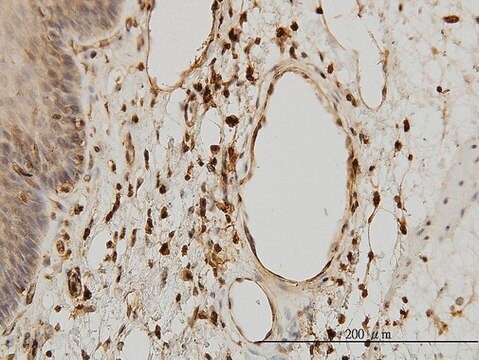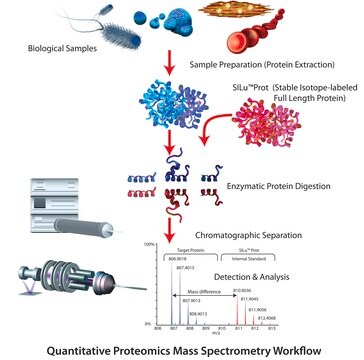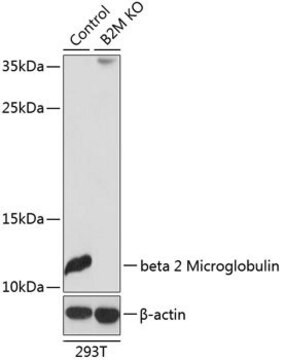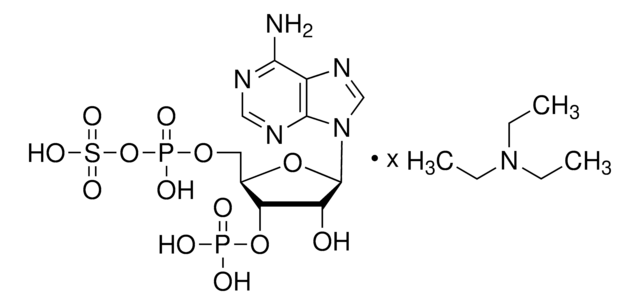Wszystkie zdjęcia(1)
Kluczowe dokumenty
M7398
Monoclonal Anti-β2-Microglobulin antibody produced in mouse
clone BM-63, ascites fluid
Zaloguj sięWyświetlanie cen organizacyjnych i kontraktowych
About This Item
Polecane produkty
pochodzenie biologiczne
mouse
Poziom jakości
białko sprzężone
unconjugated
forma przeciwciała
ascites fluid
rodzaj przeciwciała
primary antibodies
klon
BM-63, monoclonal
masa cząsteczkowa
antigen 12 kDa
zawiera
15 mM sodium azide
reaktywność gatunkowa
human
metody
indirect ELISA: 1:1000
indirect immunofluorescence: 1:500 using human PBL′s
izotyp
IgG1
numer dostępu UniProt
Warunki transportu
dry ice
temp. przechowywania
−20°C
docelowa modyfikacja potranslacyjna
unmodified
informacje o genach
human ... B2M(567)
Opis ogólny
β-2-microglobulin is part of the human leukocyte antigen, where it represents the light chain. It is expressed on cell membranes and is made up of 99 amino acids. β-2-microglobulin is part of the immunoglobulin superfamily. β−2-Microglobulin is a membrane glycoprotein of mammalian nucleated cells including lymphocytes.
Monoclonal anti-β-2-Microglobulin (mouse IgG1 isotype) is derived from the hybridoma produced by the fusion of mouse myeloma cells and splenocytes from an immunized mouse.
Immunogen
human β2-microglobulin and a lysate of a lymphoblastoid cell line.
Zastosowanie
Monoclonal Anti-β2-Microglobulin antibody produced in mouse has been used in ELISA and immunofluorescent labelling.
Działania biochem./fizjol.
β-2-microglobulin acts as a tumor marker and has been shown to be associated with dialysis-related amyloidosis. It may function as a structural part of the MHC Class I molecule.
Microglobulin may be elevated in the serum or urine of patients with systemic lupus erythematosus (SLE), rheumatoid arthritis, metal toxications, some viral infections and possibly malignant disorders and AIDS.
Oświadczenie o zrzeczeniu się odpowiedzialności
Unless otherwise stated in our catalog or other company documentation accompanying the product(s), our products are intended for research use only and are not to be used for any other purpose, which includes but is not limited to, unauthorized commercial uses, in vitro diagnostic uses, ex vivo or in vivo therapeutic uses or any type of consumption or application to humans or animals.
Ta strona może zawierać tekst przetłumaczony maszynowo.
Nie możesz znaleźć właściwego produktu?
Wypróbuj nasz Narzędzie selektora produktów.
Kod klasy składowania
10 - Combustible liquids
Klasa zagrożenia wodnego (WGK)
nwg
Temperatura zapłonu (°F)
Not applicable
Temperatura zapłonu (°C)
Not applicable
Wybierz jedną z najnowszych wersji:
Masz już ten produkt?
Dokumenty związane z niedawno zakupionymi produktami zostały zamieszczone w Bibliotece dokumentów.
The production, purification and crystallization of a soluble form of the nonclassical MHC HLA-G: the essential role of cobalt
Clements CS, et al.
Acta Crystallographica Section F, Structural Biology and Crystallization Communications, 62(1), 70-73 (2006)
Serum Beta 2-microglobulin/cystatin C index: a useful biomarker in lupus nephritis
Silva MVM, et al.
Nephron extra, 2(1), 169-176 (2012)
Alon Margalit et al.
Journal of immunology (Baltimore, Md. : 1950), 176(1), 217-224 (2005-12-21)
Level and persistence of antigenic peptides presented by APCs on MHC class I (MHC-I) molecules influence the magnitude and quality of the ensuing CTL response. We recently demonstrated the unique immunological properties conferred on APCs by expressing beta2-microglobulin (beta2m) as
A role for calnexin in the assembly of the MHC class I loading complex in the endoplasmic reticulum.
G Diedrich et al.
Journal of immunology (Baltimore, Md. : 1950), 166(3), 1703-1709 (2001-02-13)
Heterodimers of MHC class I glycoprotein and beta(2)-microglobulin (beta(2)m) bind short peptides in the endoplasmic reticulum (ER). Before peptide binding these molecules form part of a multisubunit loading complex that also contains the two subunits of the TAP, the transmembrane
Craig S Clements et al.
Acta crystallographica. Section F, Structural biology and crystallization communications, 62(Pt 1), 70-73 (2006-03-03)
HLA-G is a nonclassical class I major histocompatibility complex (MHC) molecule that is primarily expressed at the foetal-maternal interface. Although the role of HLA-G has not been fully elucidated, current evidence suggests it protects the foetus from the maternal immune
Nasz zespół naukowców ma doświadczenie we wszystkich obszarach badań, w tym w naukach przyrodniczych, materiałoznawstwie, syntezie chemicznej, chromatografii, analityce i wielu innych dziedzinach.
Skontaktuj się z zespołem ds. pomocy technicznej








